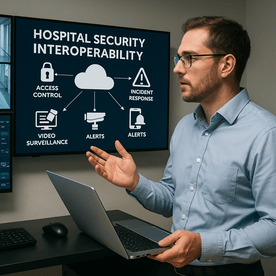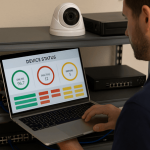
Modern hospitals rely on more technology than ever before—but when those systems don’t work together, it creates dangerous blind spots. From access control and video surveillance to visitor management and infant protection, disconnected platforms lead to delays, inefficiencies, and increased risk.
That’s where interoperability comes in.
Interoperability is the ability of different security systems and technologies to communicate, share data, and function cohesively. In a healthcare setting, it means that your physical security systems are more than a collection of tools—they’re a unified, responsive ecosystem.
In this article, we’ll explore why interoperability matters, what it looks like in a hospital environment, and how to ensure your security investments work better together.
k
k
The Problem with Siloed Security Systems
Most hospitals didn’t install all their security technology at once. Instead, systems were added over time—often by different vendors, for different departments, and with different priorities.
As a result, many healthcare facilities have:
-
Separate platforms for access control, surveillance, and visitor logs
-
Redundant or outdated hardware that doesn’t support integration
-
Manual processes to connect data across systems
-
Gaps in response times due to lack of real-time coordination
These silos not only reduce efficiency—they can also jeopardize compliance and emergency response.
k
k
What Interoperability Looks Like in Hospital Security
A hospital with interoperable systems can:
-
See a real-time access control alert and instantly review the corresponding video feed
-
Link infant protection tags with access control and surveillance for full visibility
-
Trigger automatic lockdowns based on alarms or behavioral analytics
-
Monitor multiple facilities from a single dashboard, even across campuses
It means your systems don’t just coexist—they collaborate.
k
k
Benefits of Security System Interoperability in Healthcare
1. Faster Emergency Response
In an integrated system, alerts travel instantly across platforms:
-
A forced door triggers an alarm, activates nearby cameras, and sends a mobile alert
-
Security can lock down exits, view live feeds, and deploy help—all from one interface
-
This removes the lag of switching platforms or waiting for manual confirmation
In high-stakes situations like elopements or active threats, seconds matter.
k
k
2. Improved Staff Coordination
Interoperability enables centralized communication and accountability:
-
Badge access logs can be cross-referenced with video footage
-
Visitor check-ins can be tied to area access zones
-
Incident reports can pull automatically from system data, reducing manual errors
This gives security and facilities teams shared situational awareness, no matter the time of day or department.
k
k
3. Simplified Compliance and Reporting
Hospitals are subject to audits from the Joint Commission, HIPAA, and state regulators. Interoperable systems allow you to:
-
Pull access and surveillance logs together
-
Generate detailed incident timelines with supporting video
-
Prove physical safeguards around restricted data zones
No more piecing together data from separate tools—compliance becomes proactive.
k
k
4. Lower Long-Term Costs
While integration may require upfront investment, it reduces:
-
Duplicate hardware and licensing
-
Time-consuming manual reviews
-
Training requirements for multiple platforms
Most importantly, interoperability ensures future scalability, letting you add new technology without starting over.
k
k
Key Technologies That Benefit from Interoperability
If your hospital is evaluating upgrades, prioritize systems that integrate with:
✅ Access control platforms (badging, mobile credentials)
✅ Video surveillance systems (especially with AI analytics)
✅ Visitor management tools (digital kiosks, pass printing)
✅ Infant protection and patient tracking systems
✅ Mass notification or lockdown solutions
✅ EMR or HR software for role-based access provisioning
The goal is to create a network of collaboration—not islands of functionality.
k
k
What to Ask Your Security Vendor About Integration
When vetting technology partners, ask:
-
Does your system support open APIs or third-party integrations?
-
What platforms are currently pre-integrated or certified?
-
Can your system support multi-facility visibility from one dashboard?
-
What reporting or audit features are built in?
-
How does the system support real-time alerts across departments?
If your vendor can’t answer these questions confidently, the system may not be built for the future.
k
k
Real-World Scenario: The Cost of Disconnection
Let’s say an unauthorized visitor bypasses a maternity unit’s front desk:
-
If access control and surveillance aren’t linked, staff may not notice
-
If visitor management isn’t integrated, there’s no record of entry
-
If alarms don’t connect to a mobile alert system, the response is delayed
In contrast, an interoperable system would:
-
Deny access automatically
-
Alert nurses and security instantly
-
Display real-time camera feeds
-
Log the incident for future review
Faster action. Less risk. Better outcomes.
k
k
Conclusion: Safer Hospitals Start with Connected Systems
Healthcare security is complex. But when your systems are interconnected, they become more intelligent, more responsive, and more valuable.
Interoperability is not just a technical buzzword—it’s a strategic advantage. It means your hospital is prepared for the unknown, aligned across departments, and operating with clarity.
Talk to SSP about designing an integrated, interoperable security system that protects your entire healthcare environment—seamlessly.


